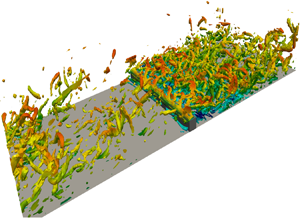Article contents
Separation drag reduction through a spanwise oscillating pressure gradient
Published online by Cambridge University Press: 10 February 2021
Abstract

An oscillating spanwise pressure gradient is imposed numerically to control the flow separation and reduce the drag of a turbulent flow in a channel with square bars. The transverse flow produces a maximum drag reduction of 25 %, due to lower pressure and skin-friction drag forces. The pressure drag reduction reaches a maximum of 22 % and is due to a decrease of the positive high pressure in front of the bars and an increase of the low negative pressure behind the bars. The skin-friction drag reduction is caused by a lower wall-shear stress along the cavity between the bars where the flow is fully attached, while the wall-shear stress on the crest of the bars and in the separated region behind the bars is unaffected. The spanwise laminar flow obtained by neglecting the nonlinear terms involving the turbulent velocity fluctuations is used to compute the power spent for oscillating the fluid along the spanwise direction and an excellent agreement is found with the power spent obtained by the averaged turbulent flow. A marginal or negative net power saved is found by subtracting the power employed for controlling the flow from the power saved thanks to the transverse flow. The control reduces the total drag as the integral of the Reynolds stresses along the horizontal line connecting the corners of two consecutive bars is decreased, which in turn impacts the pressure and wall-shear stress reductions.
JFM classification
- Type
- JFM Papers
- Information
- Copyright
- © The Author(s), 2021. Published by Cambridge University Press
References
REFERENCES
- 8
- Cited by





